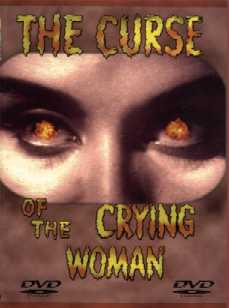 CURSE
OF THE CRYING WOMAN (1961)
CURSE
OF THE CRYING WOMAN (1961)Director: Rafael Baledon
Beverly Wilshire Filmworks/Telefilms International
 CURSE
OF THE CRYING WOMAN (1961)
CURSE
OF THE CRYING WOMAN (1961)The film begins on an homage to Bava's BLACK SUNDAY as a carriage with three passengers stops at a dark countryside forest only to encounter a raven-haired crying woman restraining three Great Danes on a leash. The crone's henchman, hidden in shadows, jumps out and throws a dagger into the driver's chest. One of the passengers flees from the scene but is attacked and killed by the mammoth canines.
Emily, another passenger on the doomed coach, goes off to a hacienda to stay with her Aunt Thelma (The Crying Woman). She arrives with Herbert (the late Abel Salazar, producer of not only this effort but also THE BRAINIAC and vampire films too numerous to mention). As Emily's parents died tragically, The Crying Woman is given the task of caring for her niece.
Emily begins to notice strange things happening at the cobweb-festooned hacienda. Her aunt casts no reflection in mirrors. Her aunt takes her to the dungeon below the casa to show Emily the rotting corpse of her ancestor. She explains that the ancestor was a witch who was executed but that her powers are carried down through the family bloodline. Thelma explains the ancestor will return to life and Emily will become a pawn in a satanic plan to join her aunt in the netherworld, that she too will crave blood and enjoy supernatural power.
Herbert, now in love with Emily, is driven to free the girl from her ancestral curse. The Crying Woman returns to the crypt and stands over her ancestor's rotting corpse. She notes that one day the witch will return to life and full powers and take vengeance upon her killer's descendants (another BLACK SUNDAY plot device).
Herbert awakens from a rest. Thelma has fashioned a voodoo doll of him and hypnotizes him. She places the voodoo doll in the flame of a candle. She relates the Crying Woman story that is told in negative stock as black magic rites are shown complete with bats, caped Satanists, vampires and sacrificial altars. The heart of the witch is pierced with a lance thus ending her reign of terror a century earlier.
But all hell begins breaking loose when the hour draws near for the resurrection of the witch. Emily, under the command of Thelma, removes the lance from the chest of the sorceress. Thelma transforms into The Crying Woman. The witch (resembling Linda Blair in THE EXORCIST makeup) starts to return to life but Herbert implores Emily not to remove the lance completely. Emily does not carry out the command and the entire dungeon begins to crumble around them. The stone towers of the hacienda transform into rubble. A massive iron chandelier falls on the Crying Woman and one of her henchmen as Herbert and Emily make their way outside to safety.
Thelma, portrayed by Rita Macedo, is wonderful as a diva of darkness lurking around corridors clad in black gowns and looking appropriately spooky. When she transforms into The Crying Woman (portrayed by Beatriz Bustamante), her eye sockets are empty and she is both sinister and sexy (a south of the border Barbara Steele, if you will).
Abel Salazar spends the greater part of the film recovering from an accident at the hacienda and does little else than look handsome and clean-shaven throughout the film. No great thesping happening here, though as a producer in Mexican horror cinema his contribution cannot be overlooked or dismissed. He is suitably cool in his role as the hero of the piece.
Emily, portrayed by Rosita Arenas, is one beautiful Latina! As an actress she elicits sympathy at the right moments and acquits herself gracefully. She had appeared in THE WITCH'S MIRROR (El Espejo de la Bruja, 1960) and three Aztec mummy films as well.
Sets are splendid and there is a dungeon very similar to THE HAUNTED PALACE (1963). The compilations of clips shown in negative stock are from numerous Mexican horror films and look fantastic. Forest scenes are appropriately unearthly and recall the twisted, gnarled tree branches and ubiquitous fog of BLACK Sunday's Moldavia as well. The tributes to Murnau and Bava just keep on coming!
Sound quality varies at times throughout this effort. This product, taken from an American-International Television 16mm sound print, looks exceptional though there is a scratch here and there. Fortunately these problems are minimal and do not deter from the overall enjoyment of this masterpiece of Mexican horror. (Christopher Dietrich)